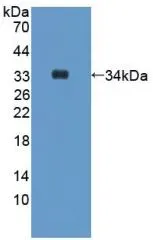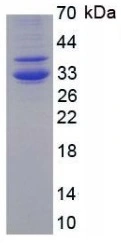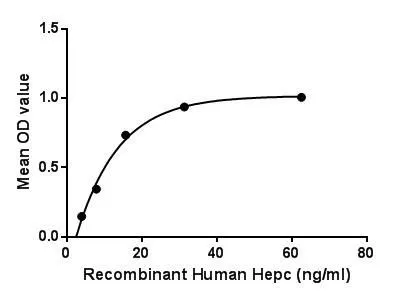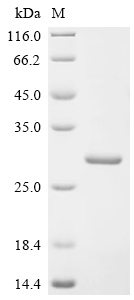
WB analysis of GTX00261-pro Human Hepcidin protein.
Human Hepcidin protein, His and Human IgG1 Fc tag
GTX00261-PRO
ApplicationsFunctional Assay
Product group Proteins / Signaling Molecules
Protein IDP81172
Overview
- SupplierGeneTex
- Product NameHuman Hepcidin protein (active)
- Delivery Days Customer9
- Application Supplier NoteHepcidin (Hepc) is a regulator of iron metabolism. Hepcidin inhibits iron transport by binding to the iron export channel ferroportin which is located on the basolateral surface of gut enterocytes and the plasma membrane of reticuloendothelial cells (macrophages). Hepcidin ultimately breaks down the transporter protein in the lysosome. Inhibiting ferroportin prevents iron from being exported and the iron is sequestered in the cells. Besides, Ferroportin (FPN) has been identified as an interactor of Hepc, thus a binding ELISA assay was conducted to detect the interaction of recombinant human Hepc and recombinant human FPN. Briefly, Hepc were diluted serially in PBS, with 0.01% BSA (pH 7.4). Duplicate samples of 100 microl were then transferred to FPN-coated microtiter wells and incubated for 2h at 37C. Wells were washed with PBST and incubated for 1h with anti-Hepc pAb, then aspirated and washed 3 times. After incubation with HRP labelled secondary antibody, wells were aspirated and washed 3 times. With the addition of substrate solution, wells were incubated 15-25 minutes at 37C. Finally, add 50 microl stop solution to the wells and read at 450nm immediately. The binding activity of Hepc and FPN was in a dose dependent manner.
- ApplicationsFunctional Assay
- CertificationResearch Use Only
- ConjugateUnconjugated
- Protein IDP81172
- Protein NameHepcidin
- Scientific DescriptionThe product encoded by this gene is involved in the maintenance of iron homeostasis, and it is necessary for the regulation of iron storage in macrophages, and for intestinal iron absorption. The preproprotein is post-translationally cleaved into mature peptides of 20, 22 and 25 amino acids, and these active peptides are rich in cysteines, which form intramolecular bonds that stabilize their beta-sheet structures. These peptides exhibit antimicrobial activity against bacteria and fungi. Mutations in this gene cause hemochromatosis type 2B, also known as juvenile hemochromatosis, a disease caused by severe iron overload that results in cardiomyopathy, cirrhosis, and endocrine failure. [provided by RefSeq, Oct 2014]
- Storage Instruction-20°C or -80°C,2°C to 8°C
- UNSPSC51180000




